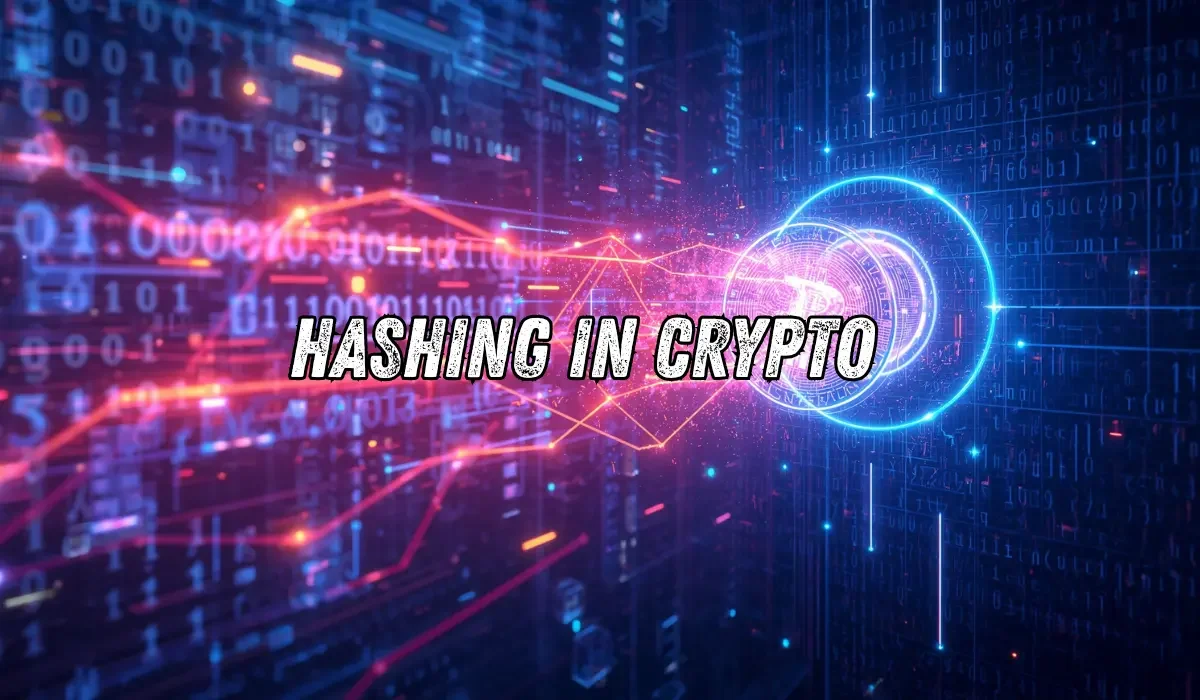What Is Hashing in Crypto? A Complete Guide to How It Secures Blockchain

Hashing is a very common term found everywhere in cryptography and crypto in general. The word hashing applies to mining, transactions, and, very much, to blockchain integrity. While hashing sounds very technical, it is indeed a foundational concept. Hashing is what allows mainstream cryptocurrencies like Bitcoin and their associated blockchains to survive.
Hashing allows these cryptocurrencies to operate securely without a central authority. This article will dive into the realms of Hashing, explaining core concepts, how it works, and why it matters to cryptocurrencies and their blockchains.
What Is a Hash in Crypto and How Does It Work?
Before understanding the process of hashing, we need to understand what a ‘Hash’ is. Hash is the output generated when data is passed through a mathematical algorithm called the hash function. The output of this hash function is usually a long string of numbers and letters. This output acts like a fingerprint in the sense that it is unique and can never be replicated with reference to the input.
The output value is what we call the Hash. It is also known as the Hash Value, and also as the Hash Code.
For instance, performing the Hash function with “hello world” as the input produces a hash. This hash looks nothing like the input hello world. Changing even one variable in this example will result in a totally different output. This property of the hash function is known as the avalanche effect. We will look into it in detail later.
The Characteristics of A Good Hash Function
Cryptographic hash functions have several key qualities. Without these qualities, a hash function is useless. We will now look at these qualities in detail.
A good cryptographic hash function must be ‘deterministic’. This means that the same input must always produce the same output. No changes at any time are allowed for the same input to generate a different output. A good hash function must be fast to compute, making it easier for deployment on the blockchain.
A hash output must be computationally impossible to generate the original hash input; this property is vital for the security of the hash function. It is called Pre-image resistance. This property is what protects the cryptographic hash function working behind blockchains. It makes the reversal and/or mutation of a block, which is achieved through hashing, computationally impossible.
A good hash function should be collision-resistant, meaning that two different inputs must never make the same output.
Why Hashing Is Important To Cryptocurrencies?
Cryptocurrencies rely on hash functions to maintain their decentralized nature. Hashing is what ensures the security and allows the blockchain to do so while remaining decentralized. Hash functions are extremely difficult to reverse. This is a vital part of blockchain technology. No transaction once entered into the blockchain must be mutated or reversed.
In the context of blockchain and cryptocurrencies, it is the hash function that ensures every transaction, block, and wallet identifier can be represented by a secure and tamper-proof digital fingerprint. This eliminates the need for any middlemen to validate data and makes the decentralized digital network called blockchain possible.
Different cryptocurrencies use different hashing algorithms. The selection of the hash function depends on the design and operational principle of the underlying blockchain of that cryptocurrency. Bitcoin uses the SHA-256 algorithm, while Litecoin uses Scrypt.
Although these hash functions are not equal to each other, they all serve the same overall purpose of converting data into a reliable and secure hash that can be used throughout the blockchain.
How Hashing Maintains Blockchain Structure and Immutability
We need to first understand how blockchains are built to better understand how hashing is an integral component for the proper running of a blockchain. A blockchain is essentially a series of interconnected blocks. These blocks are arranged in a chain-like manner, hence the name blockchain.
Each block contains a set of data, including transactions and a unique hash. This data represents the contents of the block. More importantly, every block contains the hash value of the block previous to it. In this way, the hashes are linked in a chain within the blocks, where each block depend on the integrity of the block before it.
If, by some means, someone attacks a block and tries to alter its data, the hash value within the block changes, and since the next immediate block stores the original hash, this will lead to a hash mismatch, and the action will not be validated. If this attack were to be successful, an attacker would have to simultaneously alter every single block. This is a computationally impossible action, and hence, hashing makes the blockchain immutable.
This is how hashing just does not help identify the data; rather, it secures and protects the blockchain from external attacks that could threaten the integrity of the blockchain.
How Hashing Secures Wallet Activity?
Hashing supports wallet activity because it generates public keys. When a wallet is created, the private key is hashed to make the public key. The public key is like a bank account number; it is used to send and receive crypto assets.
Hashing ensures that no entity can perform an arithmetic or algorithmic process on the public key to reveal the private key, which was used to generate the public key. This is courtesy of the pre-image resistance, which we had discussed earlier.
This way, hashing allows transparency through public keys while protecting the contents of the wallet by never revealing the private key, which was used to generate the public key and the wallet address.
Final Thoughts
Hashing is much more than a complicated mathematical operation. It is the foundational mechanism that makes decentralized systems a reality. Through the robust security and transparency provided simultaneously, hashing is what allows blockchains to operate without intermediaries, making it a fully decentralized system.
Whether you are a crypto investor, a blockchain developer, or someone who is simply curious about the internal workings of a blockchain, knowing the importance of hashing is vital to your knowledge acquisition. Understanding hashing helps you to get valuable insights into why blockchains and cryptocurrencies are secure, reliable and a groundbreaking technology of the 21st century.
Also Read: What is Decentralization in Blockchain?
FAQs
No, hashing and encryption are two different things. Hashing is used for verification and integrity, while encryption is used for privacy and confidentiality.
Yes, as computing power increases beyond today’s capacity and newer attack models are developed, hashing can become broken and outdated. However, this is not likely to happen anytime soon.
No, different blockchains have different purposes for hashing. For proof-of-work models, hashing is used to secure mining, while proof-of-stake models rely on hashing for verification and randomness generation.
No, there is no way to alter a hash without changing the data represented by the hash.
No, while hashing is used as a part of digital signatures, they are not interchangeable.




